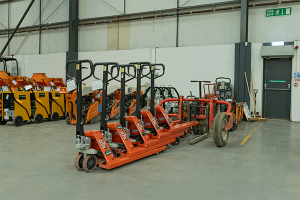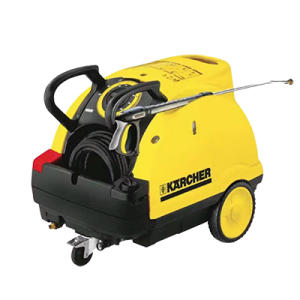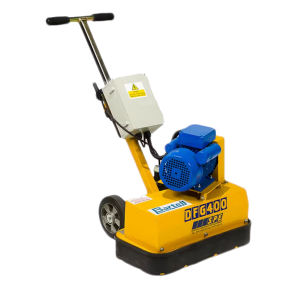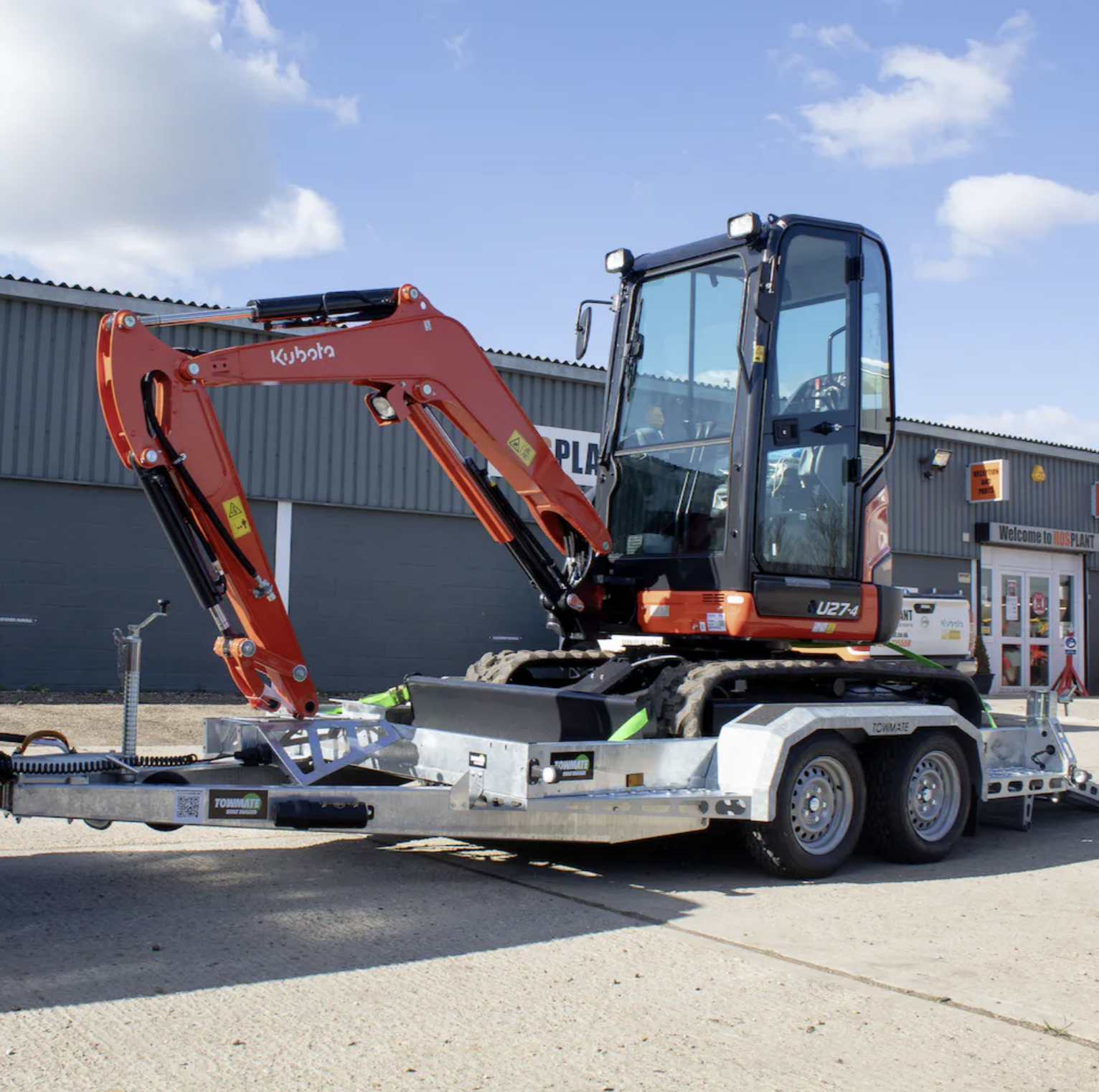
The world of Powered Access hire can seem really confusing with lots of industry terminology and acronyms making it difficult to find out what machine you actually need to hire for your project.
Fortunately, it’s a lot less complicated than it initially seems, and in this guide we're going to run through some simple things to remember and know so that you can choose the right machine and get a good understanding of what's out there in the marketplace.
Remember, it can be expensive to hire the wrong machine so if you’re unsure of what you need, speak to one of our experts who can recommend the best solution for you.
Contents
- Powered Access Terminology
- Powered Access Sizes
- Types of Powered Access Machines
- How to choose a machine
- Health & Safety Considerations
- Lifting & Moving Machines
- Brands & Manufacturers
- How to hire powered access machines
- Hire prices
- Training
Terminology
First, let’s cover some industry terminology
- Working height: the absolute maximum height of the platform plus 2 metres. If you’re asked what working height you need, it’s the height that your operatives need to reach.
- Platform height: The absolute maximum height of the platform.
- Outreach: the horizontal distance from the machine to the area of work.
- SWL: safe working load. The safe weight capacity of the machines platform/basket. Usually, machines can accommodate 2 people and their tools.
- MEWP’s: short for Mobile Elevating Work Platform.
- EWP’s: short for Elevating work platform.
- Cherry picker: slang term for boom lift, we doubt you’re actually looking to pick cherries 🍒
- Aerial platform: another term for powered access.
- Articulating boom: a boom lift where the arm has several joints along its length, vs a telescopic boom that has a single telescoping arm.
- Straight/Stick boom: a type of boom where the only extension is telescopically.
- Slab scissor lift: a type of scissor lift suited to work on flat, smooth ground.
- Rough terrain/all terrain: a term to describe a machine that can be used on uneven, bumpy ground.
- LLA: short for Low Level Access, an umbrella term for small powered access machines around 2-5m in height.
Sizes of Powered Access
We've put together a chart below showing the range of sizes for each category of powered access.
Low level access machines are best suited to indoor work at ceiling height, and most machines have a working height of 3-5 metres.
Slab scissor lifts start at around 5 metres and you can go up to around 20 metres.
All terrain scissor lifts start at around 12 metres and you can find machines that reach up to 34m
Mast lifts are available with a working height of between 6 and 12 metres
Articulating boom lifts is one of the broadest categories in powered access, and you can find machines in the range of 8 metres to 54 metres for self-propelled machines. For tracked spider booms, the smallest start at 14.5m and the largest, although rare, can reach up to 54m.
Telescopic boom lifts offer some of the highest platforms available, with the smaller machines offering around 15 metres of height and the largest, the JLG 1850SJ, offering a working height of just over 58 metres!
Types of powered access machines
There's 3 basic types of powered access machine:
- Scissor lifts - a machine that uses a scissor-like action to raise and lower a platform vertically only. provide a large, stable platform.
- Boom lifts - a machine that uses a metal 'arm' to raise a basket
- Mast Booms - a machine that uses a telescoping mast to elevate a basket vertically

Scissor Lifts
Scissor lifts are a fantastic machine to use on a construction site. Their large, stable platform provides a great place to work, with onboard 110V power and enough room to bring tools & some materials with you.
Of all the makes & models available, you can divide them into two main categories; slab scissor lifts and all-terrain scissor lifts.
Slab scissor lifts are narrower than all-terrain versions, and feature non-marking tyres which means they're a staple choice for indoor work. The reason they're called slab scissors is because they have very low ground clearance and are fitted with pothole protectors which reduces clearance to less than 50mm. Typical applications for these machines include interior fit out work, dry-lining plastering, joinery, electrical, plumbing, fire-stopping & fireproofing. As a consequence of these features, slab scissor lifts are only effective on smooth, flat, hard ground such as tarmac, concrete slab etc.
All-terrain scissor lifts, as the name suggests, are designed to be able to operate on uneven ground. They are typically much wider than their slab equivalents, the non-marking tyres are replaced with chunky all-terrain tyres for extra grip, and the ground clearance is substantially increased. In addition, all-terrain/rough terrain scissor lifts are fitted with hydraulic stabilisers that will elevate the whole machine off the ground and allow the machine to level itself even when the underlying ground is sloped. Typical applications for this type of scissor lift is installation of facades and work on commercial buildings.

Here's two versions of Skyjack's 32ft /12m working height Scissor lift. The SJ4732 is suited to use on smooth, flat ground, whereas the SJ6832RTE can be used on uneven ground.
Boom Lifts/Cherry Pickers
Firstly let's clear up some common confusion and clarify that cherry pickers and boom lifts are the same thing. There's a vast number of makes and models which can get very confusing but almost all manufacturers build machines within certain size classes which makes which make it a lot simpler.
Types of Boom lift:
- Articulated
- Telescopic
- Van/truck mount
- Tracked Spider
Similar to how you have indoor outdoor scissor lifts you also get a similar arrangement with boom lifts. For example, Niftylift manufacturer and HR12N which is a 12 metre working height articulated boom lift that features non marking tyres and relatively low ground clearance. Nifty also manufacture an HR12 4x4 which is a four wheel drive all terrain version of the same machine, which has superior ground clearance and is wider (which gives it more stability on uneven ground).
Articulated vs Telescopic Boom
Aside from the difference between indoor and outdoor versions boom lifts can be classified as to whether they're articulated or telescopic. Articulating are by far the most common but telescopic types have less moving parts and are used more in including and facades work where there isn't such a need for going "up and over" an obstacle. Articulated booms tend to be slightly more expensive, but provide far superior versatility and flexibility. Stick booms are most often found in big open spaces, and are often used for work like installing building facades or reaching tall industrial tanks.

Telescopic boom on the left and Articulating boom on the right.
Self-Propelled Boom Lifts
.jpg)
Self-Propelled Cherry Pickers are possibly the most common type of powered access we rent out to customers. Unlike a scissor lift which has a platform, Boom lifts have a basket where the operators controls the machine. They are also one of the most versatile types of access, and can reach most places with ease. One of their great benefits is their horizontal outreach, even small boom lifts offer an outreach of more than 5 metres, and larger models can offer in excess of 25 metres!
Often, you can't place a machine directly next to the area you need to reach, so having the ability to go 'up and over' an obstacle is a great advantage to these machines.
One potential downside of cherry pickers is that their basket size and capacity is often less than equivalent scissor lifts. Most cherry pickers we hire can only accommodate two people and their tools, so if you need to bring materials to the work area this is not always possible to do safely.
A question we often get asked about cherry pickers is can they tip over? They can appear to defy gravity sometimes, but manufacturers build their machines to ensure that never happens under normal conditions. Machines are fitted with overload and tilt sensors, and will prevent the operator from putting themselves at risk of tipping the machine by employing an audible alarm and stopping the boom from being extended or moved.
Tracked Spider Booms

There is another type of boom lift which is becoming a lot more popular due to its incredible versatility in tight spaces, and this is the Tracked Spider Boom. Instead of using wheels to move, the spider boom travels by moving on narrow tracks. When you're in position, four hydraulically operated legs extend out from each corner which provides enough stability to extend the boom. When in transport, these legs fold in which means that the machine can fit through a standard doorway which is incredible for some for something that could reach so high. They're also very light machines compared to scissor lifts and self-propelled boom lifts, so if you're working on grassy areas or boggy areas where a heavier product machine may sink, a Tracked Spider Boom lift is often the answer.
Hinowa's Lightlift and Goldlift range are the most common models we rent to customers. They manufacture Lithium electric and diesel powered variants to allow them to be used indoors or outdoors.
Van/Truck Mount Booms

You may well have seen these types of access machine on the road being used by telecommunications and utilities companies. They are a van or lorry chassis with a boom lift mounted on the back instead of a truck bed. The great advantage of these is that they can be driven on the road, so when you are leading to access an area where a vehicle can drive, they can be a great solution. Also, some of the largest truck mount booms can reach tremendous heights of upwards of 60 metres, so for really tall buildings a truck mount boom it is often something that we recommend to customers.
Another advantage of these is that because they are road legal, you don't need to transport them on the back of an HGV, they can simply be collected and driven to the required location. This is especially useful when you only need an aerial platform for a short period. Transporting powered access machines on an HGV is very expensive, and for short term hires you can spend as much on delivery/collection as the hire of the machine!
Towable Booms

Towable booms are not as common as other types of machines on this list, but their benefits are similar to those of tracked spider booms. These are classed as static booms, because once they have been towed into position and legs extended, they have no way to move.. In similar fashion to spider booms they are lightweight, have extending legs, yet are easy to transport.
Niftylift are the primary brand of towable boom lift we hire out.
Mast Booms

Another type of powered access is mast booms, for example the Skyjack SJ16 in the image above. Their design means they suit work in tight spaces best, and are often something we'd recommend if you're working at a height of less than 10 metres in a tight space. Bear in mind most mast booms are designed to be a 1 person machine, so for a job that requires 2 or more people we'd suggest either a scissor lift or hiring several mast booms.
As health and safety has increased over the years, manufacturers have designed machines to replace traditional options for low level access such as ladders. These days, we find that most of our customers would rent podium steps or a scaffold tower, as the stable platform with guardrails fitted is a much safer solution. The difficultly this type of access has however is that it can be cumbersome to move, and that's where mast booms come into play.
They elevate a basket vertically using a telescopic mast, and you can find many of these types of machines on construction sites across the country.
The great thing about this type of powered access is that they are incredibly compact yet offer much more productivity to workers on site as they don't need to leave the basket to move onto the next section.
Choosing the right machine
When it comes to choosing the right powered access machine, there's a couple of questions to ask yourself.
What’s the height you need to reach? (working height)
As a quick guide, each floor is usually around 3-4m, so by counting the number of floors you can get a quick estimate on how high you need to go. e.g. for a building with 3 levels of windows where you need to access guttering, the height is likely to be approximately 10-12 metres. Provided there's not much outreach required, we'd likely recommend a 14 metre Articulated Boom Lift.
What’s the maximum outreach you need?
Look at the ground where the base of machine will be positioned. What horizontal distance do you need to reach the work area?
What are the ground conditions like?
If the ground is relatively smooth, surfaced in concrete or tarmac, you should be able to use a slab scissor lift or any boom lift. If the ground is hard but uneven, you'll need an all-terrain scissor lift or cherry picker. For soft ground like grass, we'd suggest a tracked spider boom due to their low weight. Remember that even small scissor lifts and mast booms often weigh over a ton - we've dealt with many stranded machines over the years!
Are you working indoors or outdoors?
If outdoors, you can choose a diesel powered machine if you like. if you're working indoors, you'll need an electric machine to avoid producing fumes in the confined space. Electric machines need to charge their batteries via 110V power - is this available on site?
What basket capacity do you need? How many people need to be in the basket? What tools & materials will they be using?
Scissor lifts are great if you need several people and/or materials to be at the work area, as the deck area and capacity is much greater than a boom lift. If its just one or two people with hand tools, a boom lift should be fine.
Are there any access restrictions? The lorry delivering the equipment as well as the route to the location. Any side passages/doorways?
Think about the route to the work area - is there anything that would prevent an HGV accessing the site? Designate an area to safely unload the machine. similarly, think about the route the machine will take - if it needs to pass through doorways or turn a tight corner, check the specification of the machine beforehand. For the most challenging locations, we often recommend hiring a tracked spider boom. In rare circumstances, an alternative form of access like a scaffold tower may be the only option.
Understanding the working envelope
Each machine has a 'working envelope' which is a term to describe the theoretical area you could cover by having the machine in every different position.

Here's an example of the working envelope of a Niftylift cherry picker. from reading the graph we can learn that the HR15N has an outreach of about 9 metres, however this reduces once you go above 9m in height.
Health & Safety considerations
I'd like to touch on some of the health and safety considerations when hiring powered access. Firstly we'd like to recommend that anyone operating powered access wears a suitable harness at all times, and that the harness is connected via short lanyard to the basket. All powered access machines are fitted with eyelets in the basket which the operator connects themselves to. The lanyard should not allow operatives to move out of the basket, typically we'd offer a lanyard of 1 to 1.5 metres.
Lifting & moving powered access machines
Pretty much all smaller machines are fitted with forklift pockets, so can be moved around with a forklift or telehandler. Also, most if not all machines are fitted with crane lifting points at each corner to allow them to be moved into position. We find this common practice on large multi-storey sites.
Make sure the machine you hire has the required certification to lift before you attempt it. All machines we deliver are provided ready to hire, with a valid certificate as relevant to the specific machine. Depending on the type of machine, they will need a valid LOLER certificate or Thorough Examination Certificate.
Powered access brands & manufacturers
This is by no means an exhaustive list, but here are some of the most common brands of powered access in the UK:
- Genie
- Skyjack
- JLG
- Niftylift
- Holland Lift
- JCB
- Snorkel
- Manitou
- Hinowa
- Dingli
- Teupen
- Nagano
- Zoomlion
- Haulotte
- LGMG
- Sinoboom
How to hire Powered Access Machines
Placing your order
Ordering your machine is very simple. As a pre-requisite, you'll need hired-in plant insurance and a credit account with us.
- Choose your machine. Browse our range or email [email protected] if you need help.
- Place the order. You can order online (provided you're logged in, register here if you haven't) or by contacting our hire team.
- Off-hire when you're done. By default, we offer hires on an 'open hire' basis, where you keep the machine indefinitely until you instruct us to off-hire the machine and collect it. you can do this online or by contacting our hire team.
Delivery & Collection
Machines are notoriously heavy, with even small scissor lifts weighing well over a ton and boom lifts weighing over 10 tons. As such, powered access machines are usually delivered by large HGV’s.
Lead times on delivery do vary, but we can usually offer next-day delivery on powered access machines, For smaller machines, we can often deliver same-day if you need.
The vehicles we use to deliver powered access machines depend on the size and quantity of machines ordered, but generally:
- Low Level access is often delivered via 3.5t or 7.5t van
- Scissor lifts & boom lifts are often delivered by 26t or 32t Rigid HGV, sometimes an 40t+ Articulated HGV
Please allow up to 1 hour for the driver to complete a safe load or unload. All our drivers are equipped with PDA devices to capture signatures, take photos, and check off machines & components/accessories.
Hire Prices
Now that you've read through this guide, you might be thinking to yourself great - now how much is this going to cost me?
- Low Level access up to 5m in height often costs between £50 and £100 per week to hire.
- Slab scissor lifts cost between £100 and £400 a week, the all-terrain versions are quite a bit more and go for £200-£500 a week to hire.
- Articulated booms/cherry pickers cost between £250 for a week to over £2,000 a week to hire.
- Tracked Spider booms cost between £600 and £1,500 a week to hire.
For a 1 week hire, the total cost for an 8m electric scissor lift would be approximately £300 excluding VAT.
A 12m boom lift for a 1 week hire will cost approximately £450 excluding VAT.
Transportation (delivery & collection) for Scissor lifts and cherry pickers is usually between £75 and £150 each way, depending on the location, distance from branch and size of machine.
The real saving in renting powered access machines is in the increased productivity of labour on site - a team of skilled installers can complete projects significantly faster with the use of machinery to help them, and it costs a lot less than using slower methods for longer.
Powered Access Training
Operatives should have a valid IPAF qualification to use machines.




